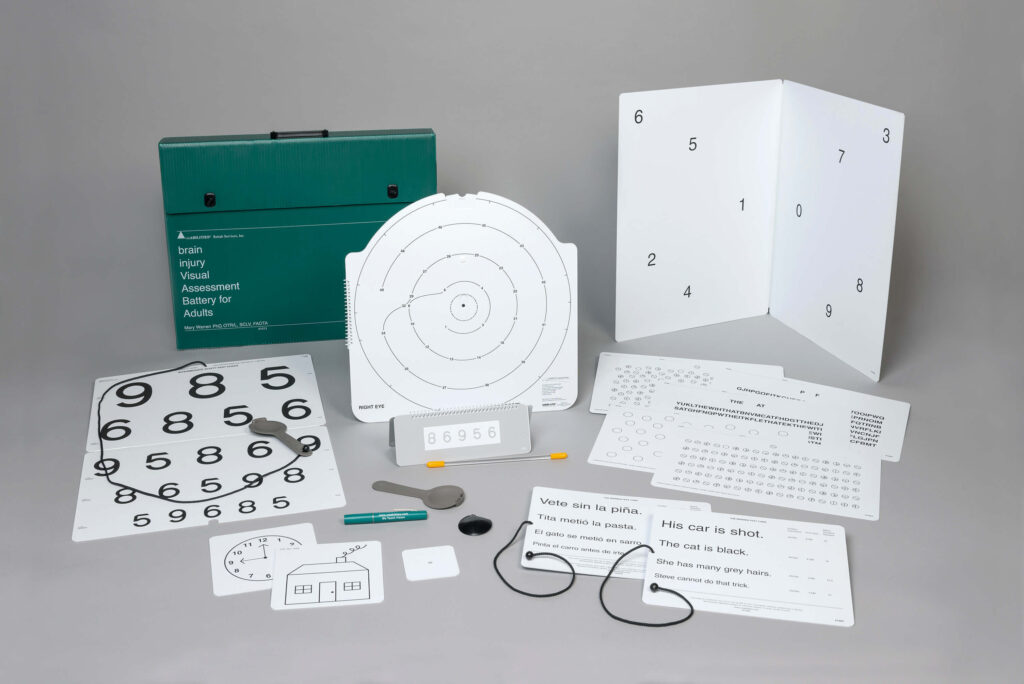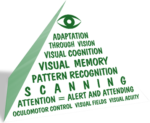biVABA

The biVABA (Brain Injury Visual Assessment Battery for Adults)
Developed by Mary Warren PhD., OT, SCLV, FAOTA
Based on thirty years of clinical practice and research, the biVABA provides a practical tool for completing a quick, accurate, reliable and useful assessment of the client’s visual processing ability following adult acquired brain injury. The battery focuses on identifying the client’s functional limitations from visual impairment and using that information to provide effective interventions.
The battery includes standardized assessments for evaluating the visual functions important to ensuring accurate visual perceptual processing:
Visual acuity (distant and reading)
- Contrast sensitivity function
- Visual field
- Oculomotor function
- Visual attention and scanning
The comprehensive test manual provides:
Detailed instructions on how to give and interpret each assessment
- Functional limitations associated with different types of vision impairment
- Instructions on how to use assessment results to write interventions goals
- Instructions on how to use assessment results to select and design interventions
- Alternative methods for evaluating persons with limited capability to respond
Lightweight and completely portable, the biVABA is designed to be used with adults who have sustained brain injury from such conditions as stroke, TBI, brain tumor, multiple sclerosis, Parkinsons disease and dementia. Components of the test can also be used to evaluate low vision conditions associated with macular degeneration, diabetic retinopathy, glaucoma and cataract.
Product Warranty: visABILITIES products are warranted for one year from the date of purchase against manufacturer defects. Warranty is valid provided that the products have not been subjected to abuse, mistreatment or excessive wear. If failure develops within the applicable One Year Limited Warranty period, and is deemed to be a result of a defect in materials or workmanship, visABILITIES will replace the item with the same item or equivalent visABILITIES item.
The Advantage of biVABA over Other Assessments
The biVABA guides intervention planning
We consider evaluation to be the first step of intervention. Where other tests only label the perceptual deficit, the biVABA guides intervention planning by showing how
- Visual processing has changed as a result of brain injury
- How functional performance may change because of the visual processing deficit
- The best evidence-based intervention to achieve an optimal client outcome
The biVABA assists in identifying the client’s rehabilitation potential and setting achievable goals
The biVABA was designed to be an intervention tool rather a diagnostic battery. Therapists are allowed to use cuing, re-dos and modifications during assessment to determine the client’s strengths and weakness in using vision to complete activities. The information gained from assessment assists identifying the client’s rehabilitation potential, the most appropriate intervention goal and the number of sessions required.
The biVABA enables early detection and remediation of visual deficits maximizing functional outcomes and saving money
The biVABA provides instructions for modifying assessments to accurately measure visual processing in clients with limited cognition, language and attentional capabilities so that visual processing deficits can be identified early in the client’s recovery. Early detection of vision impairment helps ensure that treatment dollars will not be wasted working with clients whose unidentified visual deficits prevent them from fully participating in and benefiting from therapy.
The biVABA includes all of the assessments needed to complete a comprehensive assessment of the client’s visual processing
While other tests may only measure one aspect of visual perceptual processing requiring the purchase assessments, the biVABA contains all of the assessments needed to complete a comprehensive evaluation of the client’s visual function.
The biVABA is easy to administer and interpret
The evaluations included in the biVABA are easy to administer and simple to score.
- The assessment forms use a check list format that makes it easier to add to an EMR.
- Each assessment form includes check-lists identifying the client’s strengths and weaknesses in using vision
- The test manual contains a section on interpretation of test performance for each area of visual processing-plus appropriate goals.
The biVABA equips the OT to explain visual processing deficits to the client, family, physicians, rehab team members, insurance companies and other stakeholders
While other test kits provide a brief booklet of instructions, the biVABA provides a comprehensive manual that-in addition to detailed test instructions-includes sections on:
- How visual processing changes following brain injury
- A clinical framework to guide evaluation and intervention
- Descriptions of the most commonly occurring visual impairments following acquired brain injury and their effect on functional performance
- How to interpret test results to clients and family
- How to collaborate with and refer to optometrists and ophthalmologists
- How to use test performance to develop a treatment plan
- How to use test performance to select the most appropriate intervention
The biVABA can be used to evaluate clients with age-related eye disease and low vision
The biVABA contains assessments that can be used to measure visual function in persons with low vision from macular degeneration, diabetic retinopathy, glaucoma, and other conditions. These assessments include: LeaNumbers Intermediate Acuity Test Chart , Warren Text Card (English and Spanish versions), LeaNumbers Low Contrast Acuity Flip Chart, 2 Person Kinetic Test, Damato Campimeter
